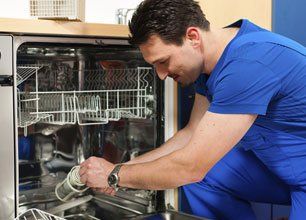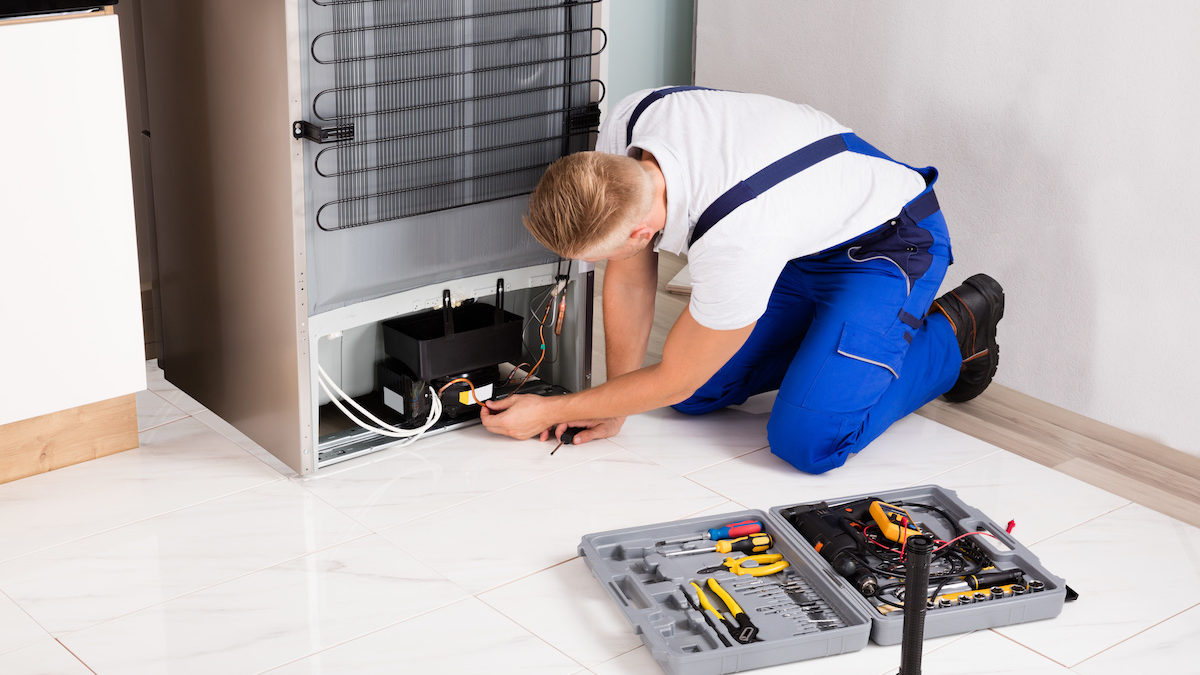How Much Is That Fridge Really Costing You? Find Out with a Call to Dependable Refrigeration Appliance SubZero repair near me
How Much Is That Fridge Really Costing You? Find Out with a Call to Dependable Refrigeration Appliance SubZero repair near me
Blog Article
The Ultimate Guide to Do It Yourself Appliance Fixing Techniques
When devices break down, it's very easy to feel overloaded. Dependable Refrigeration & Appliance Repair Service SubZero Repair. With the best understanding and devices, you can tackle typical issues on your own. From fridges to dish washers, recognizing exactly how to troubleshoot and fix these tools can conserve you time and money. Are you ready to uncover necessary strategies that will empower you to take care of repair work confidently? Let's discover the vital areas where DIY abilities can make a substantial difference.
Comprehending Usual Appliance Issues
When you count on your home appliances, it can be irritating when they suddenly stop working or break down. Comprehending common appliance problems can help you repair concerns successfully. For example, if your refrigerator isn't cooling, check the temperature level setups or examine the door seal for gaps. A defective washing machine could be as a result of a clogged up drainpipe filter or a damaged belt.
If your oven isn't home heating, malfunctioning elements or thermostat concerns can be to criticize,. Dishwashers frequently experience problems with water drainage, so see to it the filter is tidy and the drainpipe hose isn't kinked.
Likewise, pay attention for uncommon audios; they typically show mechanical problems. By identifying these signs, you can save time and potentially avoid expensive repair work. A little knowledge goes a lengthy means in keeping your devices, so stay informed to keep every little thing running efficiently.
Necessary Tools for DIY Repairs
Prior to diving right into DIY device repair work, it is very important to gather the right devices to ensure the procedure goes efficiently. Start with a good set of screwdrivers, including both flathead and Phillips, as they're important for opening most devices. You'll likewise want a set of pliers for gripping and twisting cables or tiny components.
Don't fail to remember a multimeter; it assists you examination electric components and diagnose problems properly. An outlet set comes in handy for loosening or tightening up screws, while an energy knife can be helpful for cutting cables or opening up packaging.
Lastly, take into consideration having a flashlight available to brighten dark rooms inside your appliances. With these vital tools, you'll be well-appointed to tackle different repair services, saving both time and money. Gather your gear and obtain all set to roll up your sleeves!
Safety First: Preventative Measures to Take
Before you start any type of device repair work, it's vital to prioritize security. Make sure you put on individual safety equipment, disconnect the power source, and maintain your workspace organized. These simple preventative measures can assist stop crashes and assure a smoother repair procedure.

Personal Protective Tools
Security equipment is an important part of any type of DIY device repair work task. You need to always put on safety and security goggles to secure your eyes from dust and particles. A durable pair of handwear covers will certainly secure your hands from hazardous materials and sharp sides. Take into consideration making use of a mask if you're taking care of chemicals or dust, ensuring you breathe safely while functioning. Steel-toed boots are also a smart choice, especially when raising hefty home appliances. Don't forget to wear lengthy sleeves and trousers to secure your skin from prospective injuries. By prioritizing personal protective tools, you'll substantially lower the danger of mishaps and injuries. Keep in mind, being prepared with the best gear maintains you secure and concentrated on finishing your fixing efficiently.
Source Of Power Interference
To assure a secure Do it yourself device fixing, detaching the power source is crucial. This basic action prevents electrical shocks and warranties that you can concentrate on the fixing without fretting regarding unintended activation. As soon as you're certain that the power is detached, you can confidently continue with your repairs, understanding you have actually taken the required preventative measures to shield on your own.
Job Location Company
An efficient job area can make all the difference in your DIY appliance repair project. Start by removing your work space of mess to protect against crashes and interruptions. Outline all your devices and products, organizing similar products with each other for very easy access. Make use of a tool kit or coordinator to maintain little parts like screws and washing machines contained and labeled. Ensure you've got adequate lighting; it'll help you see details clearly and decrease the danger of blunders. Do not neglect to maintain safety and security equipment like gloves and safety glasses available. Ultimately, have a trash can useful to deal with waste quickly. A tidy space not only improves effectiveness however also maintains you risk-free while you work with your appliance repair.
Step-by-Step Guide for Fridge Fixes
When your refrigerator starts acting up, it can be discouraging, yet taking on the trouble on your own can save you time and money. Check for common issues like temperature fluctuations or unusual noises. For a noisy refrigerator, examine the follower and validate it's not obstructed.
If there's water pooling within, check the door seals for damage or see this page dust, and tidy them if essential. For ice buildup, clear the defrost drain. When you've resolved the concern, connect the refrigerator back in and monitor it for a couple of hours. If the issue persists, you may require to replace a faulty part, like the compressor or follower electric motor. Keep in mind, don't wait to consult the manual or seek specialist aid if needed.
Dealing With Washing Device Concerns
Much like refrigerators, washing devices can provide their own set of obstacles, yet lots of problems can be solved with a little bit of troubleshooting. If your maker won't begin, inspect the power cable and verify it's plugged in. Next off, examine the door latch; a malfunctioning lock can protect against the cycle from starting. It might be due to foreign items stuck in the drum or the drainpipe pump. if you discover unusual sounds throughout operation.
If your clothing aren't obtaining tidy, think about the water degree and detergent kind; using as well much cleaning agent can develop excess suds, impacting efficiency. For leaks, examine the hose pipes for fractures or loosened connections. Tightening these can often fix the trouble. Regular upkeep, like cleaning the filter, can stop many issues from emerging. Keep in mind, a little troubleshooting goes a long way in maintaining your washing device running smoothly.
Repairing Ranges and ovens
Just how can you troubleshoot usual problems with your stove or range? Beginning by inspecting the power supply.
If your stove isn't heating, inspect the temperature level settings and verify the door seals snugly. A damaged heating element might also be the wrongdoer; you might require to replace it if it's damaged.
For uneven food preparation, turn your pans and think about utilizing an oven thermometer to verify accurate temperatures. Lastly, if you listen to unusual sounds or scent gas, switch off the home appliance right away and speak with a specialist. By complying with these actions, fix my dryer near me you can recognize and fix many usual stove and cooktop concerns efficiently.
Fixing Dishwashers Facilitated
When your dishwasher starts acting up, it can be discouraging, but resolving common concerns isn't as hard as it seems. You'll learn detailed troubleshooting methods that will certainly assist you pinpoint the problem, in addition to the vital tools you'll need to take on repair work on your own. Allow's make repairing your dish washer a breeze!
Common Dish Washer Concerns
While dishwashers are created to make your life less complicated, they can sometimes run into usual concerns that leave you really feeling annoyed. If your dishwasher's door will not latch, it could be a basic issue with the latch mechanism or door seal. Resolving these concerns early can conserve you time and problem down the roadway.

Step-by-Step Troubleshooting
Before diving into repair services, it's essential to identify the particular concern your dishwasher is dealing with. If it's not cleaning appropriately, Start by checking. Evaluate the spray arms for blockages and warranty they rotate openly. If it's dripping, check out trash compactor repair door seals and tubes for any kind of damage. For unusual sounds, pay attention very closely during cycles; international objects may be embeded the filter or impeller. Check the power supply and door latch if your dish washer will not begin. Don't fail to remember to consult your customer guidebook for troubleshooting suggestions certain to your version. By carefully dealing with each prospective concern, you can determine the trouble and take the necessary steps to repair it, making your dish washer function like new once again.
Crucial Repair Tools
Having the right tools at your disposal can make all the difference when fixing your dish washer. Do not forget a container or towels for any water spills during fixings.
You might also desire a level to assure your dishwasher's correctly lined up. With these necessary devices, you'll be well-equipped to take on any kind of dishwasher fixing difficulty that comes your way.
Often Asked Questions
If a Home Appliance Is Well Worth Fixing?, just how Do I Determine.
To identify if a home appliance's worth fixing, consider its age, fixing prices, and current value. If repair work surpass half the substitute price, you might want to invest in a new design rather.
Can I Discover Replacement Parts Locally for My Home Appliance?
Yes, you can often discover substitute components in your area for your appliance. Inspect hardware shops, home appliance fixing stores, or neighborhood classifieds. Do not neglect to bring the design number to ensure you obtain the proper component!
What Typical Mistakes Should I Prevent When Repairing Home Appliances?
When fixing home appliances, prevent hurrying via diagnostics, overlooking safety and security preventative measures, or utilizing inaccurate tools. Don't avoid reviewing handbooks or viewing tutorials; they offer essential guidance. Be client and detailed to guarantee successful fixings and stop more damages.
For how long Does a Normal Do It Yourself Home Appliance Fixing Take?
A regular DIY home appliance repair service normally takes one to 3 hours, depending on the complexity. You'll wish to gather your devices and products initially, and comply with guidelines carefully to stay clear of unneeded delays.
Are There Any Warranties for DIY Home Appliance Repair Works?
When you deal with do it yourself home appliance repair work, guarantees normally do not cover your job. Some manufacturers could recognize warranties for components you change. Constantly inspect your appliance's guarantee terms before starting any kind of repair services to avoid concerns.
Before diving right into Do it yourself device fixings, it's crucial to collect the right tools to ensure the process goes efficiently.Before you start any type of device fixing, it's crucial to focus on security.To ensure a secure Do it yourself home appliance repair work, detaching the power source is vital.A well-organized work location can make all the distinction in your DIY home appliance fixing project. Constantly examine your device's service warranty terms prior to beginning any type of repair work to avoid issues.
Report this page